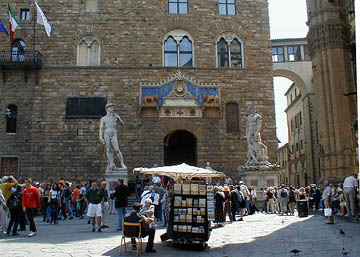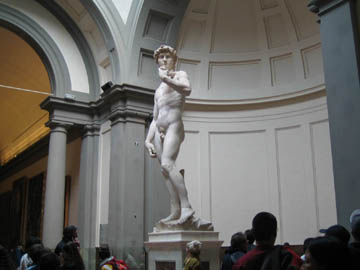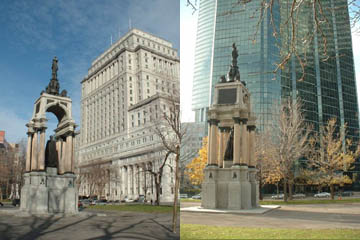What happens to sculpture in the real world of time and history? The Serra exhibit reminders me of all the discussions that I had with Tom Finkelpearl and Kyong Park during the Storefront for Art and Architecture exhibition on the Titled Arc in 1985. Serra’s sculpture was precisely made for the site, but what would happen when the site changed – the front door relocated or even the buildings demolished? If the site was essential to “Titled Arc” as Serra claimed, then the work was bound to be destroyed when the world changed around it.
Finally after 30 years in the USA, the public art profession firmly knows its responsibilities for artwork maintenance. But what about context maintenance? How much responsibility exists for placing the work as it was intended? Once this is impossible as the context mutates or the artwork must be moved, how do we think about it?
The most famous is Michelangelo’s David. People know the work from the protected museum setting, not the outdoor plaza where the scale and role of the work is much different. Almost every art history book presents the work with even light and white walls, not the harsh sun and rough stone of the palazzo.

Fake David with Bandinelli’s Hercules at Palazzo Vecchio in Florence

Real David Indoors with a museum neutral background
This sculpture in Montreal has entirely different feeling when examined against the early 20th century beaux art building. Here the sculpture blends with and accentuates the attributes of building. Juxtaposed (I bet the sculptor never considered juxtaposition – now a bedrock of contemporary public art reality.) with the 1980s glass, the artwork is a sweet, decorative music box.

Montreal
At the Aesthetic Grounds visual essays site, I have posted some other comparisons. Some are photographing the same work with different back drops. Other such Aristide Maillol, “River” or Jonathan Borofsky’s Hammering Man, the reproduction of the work creates opportunities for comparison around the world.
The original installation of the artwork is only phase one in a potentially long history. The protectors of contextless objects in the museum, universities and galleries have no mandatory interest in the context driven public art. Therefore, the public art field needs to build its own intellectual methodology as all other institutions have a vested interest in ignoring the meanings and connotations of physical context.
See the CONTINUED text for documentation and Chris’ excellent observations regardin moved art in Philadelphia on Chris Purdom’s philart.net. Report on July 26, 2007
From Chris Purdom in Philadelphia
I’ve started documenting context changes on
philart.net as stuff gets moved around. These are to
me particularly bad.
Flame worked pretty well in a fairly enclosed space
surrounded by late 60s and early 70s urban fortress
architecture. Sitting on a corner with a Michael
Graves behind it, it looks old and lost.
Double Figure Eight echoed the windows of the Furness
behind it. While not as out of place looking as
Flame, it now looks like an afterthought.
And Bench Form, which was in the same park as Double
Figure Eight originally was stark and startling. Now
it looks like a bench with a funny background.

No matter how much thought is put into making a piece “site specific” or relevant to the community, a piece of public art is, in the end, just another object. And, like any object, as it gets older, all memory of its original context, meaning, and relationships to the society and culture in which it was created get lost or forgotten, and the object needs to make it on its own.
Strong objects, with personality and soul, will endure, regardless of site. Egyptian Stellae are sited in modern steel and glass skyscraper lobbies, or on desolate windswept plains, where every other building has crumbled, and still shine thru.
The artist puts something in, and, if they are any good, that something will still radiate back out as long as the piece lives, no matter the site.
Certainly some very minimal, site specific pieces may not survive context changes- but that is a chance an artist takes, when initially imagining that type of work.
A few artists will have the reputation to keep the sites maintained, in the short run, ie. for a hundred years or so- but beyond that, its all the luck of the draw.
Happily, many older artworks do indeed get second, and third and more, lives, in new sites, and although they may mean very different things to us than they did to their original viewers, they hang in there.
Response from Weiss
The artist makes while responding to the physical, social, etc context of the moment. But what about the caretakers, administrators and curators? How do they think about the relationship of the mutating context? At what point and for what reasons do you remove the work from the context because of the mutations? Do you ever “restore” the context for the work?
You bring up a good point that certain types of artwork might be more self-sustaining in any context. I need to think about all of it based upon real experiences of works out there in real space.
As one who has had terrible experiences with the handling of my work in public places, I find this post very important in its observations about changing sites. When the “owners” of the pieces move them without consulting the artists, particularly if they have been funded with public money, then they are breaking the 1990 Visual Arts Right Law passed by Congress, which stipulates that mutilation, changes to the work (which would include moving the piece) can not occur without the consent of the artist. Of course, expecting such an art adverse administration with such a justice department we have at present to enforce this law is to dream.
Response from Weiss
VARA has been tested in court. VARA only includes the physical object itself. It provides no protection regarding the relationship of site and artwork.
I created an “art proposal” format such that artist’s can declare site issues part of the artwork AND the agency can accept those restrictions. I have used the format and usually ARTIST’s don’t take advantage. The artist can stipulate anything from lighting to background color to tree trimming to social context. The solution is the contract, not VARA for the moment.
But also the solution is education of public art administrators to seek assistance on new placement from the artist, or if not available, professional curators.
Philadelphia’s latest huge move of public art, the Great Mother and Great Doctor from in front of the prison on the Parkway to the new School of the Future on the other side of the river.
http://www.philart.net/landmark.php?id=153
The pieces are visually appropriate to the new site, in a kind of Star Trek Next Generation set way. But they were commissioned as a rather misleading emblem of a youth prison, and I kind of wonder at the symbolism. Is the art reformed by the more uplifting site, or is the school now linked to the prison?